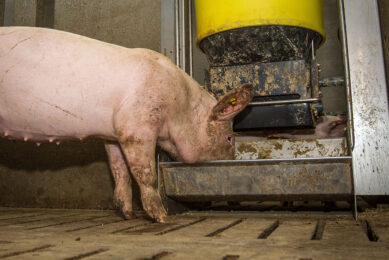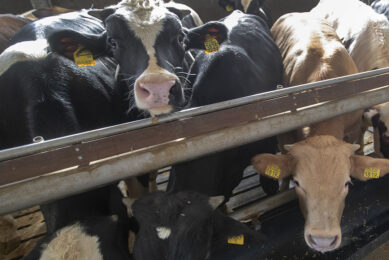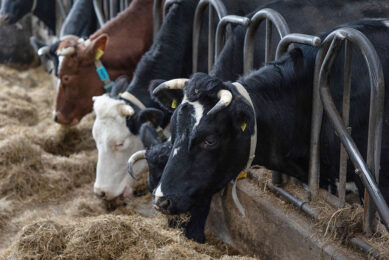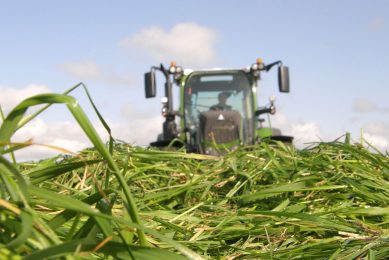Feeding equipment reviewed: Efficiency, cost and environment
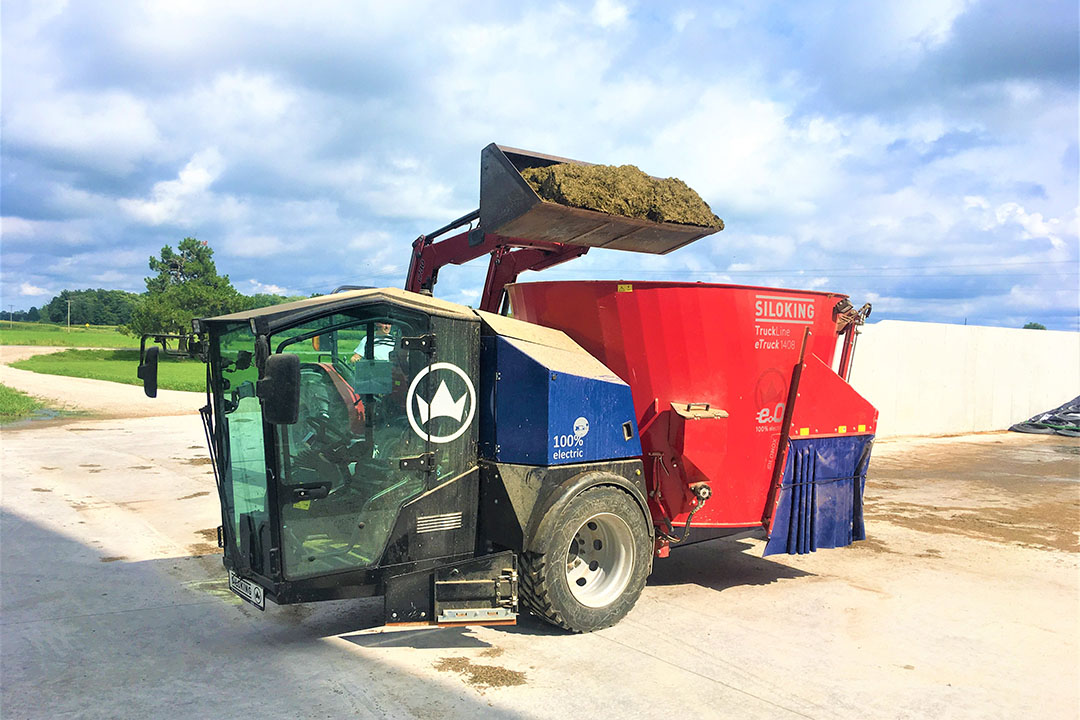
A roundup of new electric, mobile and/or automated machines currently available to producers and a look at how much the demand for this equipment is growing.
Every year, more new electric and automated farm machinery come onto the market, and that should not be a surprise. Farmers are very interested in environmentally-friendly equipment and systems with zero emissions and no noise. And, now that battery lifespans are longer and some equipment can even use solar power, demand is stronger than ever. To get the latest news on products, we’ve contacted some major manufacturers, along with 2 farmers and a scientist to get their perspectives on their use as well as the outlook for the years ahead.
 Siloking eTruck TMR feed mixer
Siloking eTruck TMR feed mixer
Farmers experience
Klaas-Jan Buist of Buistlane Farms in Canada (Mount Elgin, Ontario) purchased the 8 m³ Siloking eTruck TMR feed mixer in 2018 after having it on the farm as a ‘demo’ for a few months. Buist explains that for years he had already had a self-propelled TMR mixer and feed cart all-in-one, and he was in favour of another self-propelled machine to do these jobs in an expanded way in a new barn.
“We did our research and found that Siloking had an electric mixer and I thought ‘this is worth trying’,” says Buist. “The total cost of ownership was comparable to other systems and when we had it as a demo, we found out that it really shines in terms of energy consumption.”
– Costs of charging feed mixer
Buist charges the unit every third day at night when electricity rates are lower. “In the winter, you usually have to charge it every second night, and the cost is about CAD$ 3 to charge it, so that’s $ 1 to $ 1.5 a day,” he says.
– Noise and emmissions
“And then there’s minimal noise and zero emissions. In the autumn, winter and spring I can load feed the night before and start it up with no issues in the morning, even after the feed has settled. The electric motor has tremendous torque. I was not going to sacrifice anything on mixing quality and I don’t with this unit. It makes a fantastic homogeneous mix. The feedout is consistent and cleanout is perfect.”
Cost-effective and efficient for feeding
Siloking also makes the ‘eSilokamm,’ a self-propelled electric-powered silage collection and distribution machine. For its batteries, Siloking works closely with a European forklift manufacturer that has many years of proven experience. “One of the challenges of battery technology in general is still the weight and space it takes,” says Reto Ammann at Siloking Canada. “But in our situation, Siloking made the heavy weight of the battery pack an advantage for the machine concept and we use the weight of the battery to put more weight on the drive axle, which results in more traction in the winter months, for example on snow and ice.” He expects battery technology to continue to improve. Ammann believes that right now with the battery-driven electric equipment technology that’s available, electric feeding machines are nicely suited for small and medium-sized dairy farms as they are cost-effective and efficient for feeding. He believes that “government grant programmes, similar to those in some European countries that support environmentally-friendly technologies on the farm will certainly drive the market for this technology.”
 Ruminant feeding in the face of disease and parasites
Ruminant feeding in the face of disease and parasites
This article offers some insights into the most common disease problems in cattle and the feeding strategies that can be adopted to reduce the impact of sickness on animal production and the profitability of farm operations.
 Triomatic HP 2 300 hanging feeding robot
Triomatic HP 2 300 hanging feeding robot
For automated feeding in the barn, Trioliet offers the rail-suspended Triomatic HP 2 300 hanging robot for situations in which there are differences in height between barns. “We have the Triomatic WB 2 300 feeding robot on wheels using a power rail if everything is quite even and a high capacity is required,” says Triomatic sales manager, Stefan Schulte. “One robot can feed up to 700 head of cattle and we can combine multiple robots in a system. We are currently building a system to feed 1400 milking cows.

Triomatic WB 2 300 battery-driven robot
We now have the Triomatic WB 2 300 battery-driven robot if rails are impossible (where there is low roofing or if the robot travels between barns with an important driveway in between).
All Triomatic robots have a 3m³ mixing tub with 2 vertical augers.” Schulte and his colleagues notice that more and more farmers are interested in robotic feeding. “It’s hard to get qualified employees and also saving on labour and energy costs is getting more important,” he says. While he acknowledges that the cost of a robot feeder is higher than that of a trailed mixer, he believes that the difficulties in finding qualified labour and the energy savings will propel the investment in robotic feeding. “Also,” Schulte adds, robot feeding can enable “dedicated feeding of all groups of animals multiple times per day, which increases feed efficiency.”
 Interview with Cainthus CEO: Feed tech zooms in on each cow
Interview with Cainthus CEO: Feed tech zooms in on each cow
Dublin-based agtech firm Cainthus, recently launched its bespoke feed technology that can monitor cows in real time, 24/7. We talked to CEO Aidan Connolly.
 Triomatic T30 feed kitchen with WB robot
Triomatic T30 feed kitchen with WB robot
Farmers experience
Mark Kruidhof and his family have had a T30 with WB robot since 2019 on their dairy farm (with a 150-cow milking herd) in Ommen, the Netherlands. Before they got it, they had an self-propelled feed mixer and decided to look for other feeding options because of diesel consumption and the time it took to feed all the animals. “We like how the Trioliet T30 is accurate in both the amount and the mixture of the feed,” says Kruidhof. “Our cows eat smaller and fresher portions many times a day. Because of that our cows are eating more and we see an increase in milk production.”
We like how the Trioliet T30 is accurate in both the amount and the mixture of the feed.”
– WB robot
In terms of the WB robot, Kruidhof thinks using a feeding robot is the way ahead, saving a lot of time on feeding that can be better spent on other things. He notes that the WB is still in a pilot phase and they’ve had to add a door from another supplier that opens automatically to allow the robot entry. “Problems in communication between the robot and the door system can lead to disputes, because each supplier can claim that the problem does not lie in their product,” he says. “We would suggest an all-in-one solution.” Their robot has to drive outside to get to the feed kitchen and different cowsheds and Kruidhof says it’s better when the robot has the space to stay in the cowshed. “This way you don’t have to think about where you leave your tractor and if the robot is going to bump into it,” he explains.
 Super SmartFeed: Portable, solar precision cattle feeding
Super SmartFeed: Portable, solar precision cattle feeding
Next up is an electric and portable precision cattle feeding machine, the Super SmartFeed made by US-based C-Lock.
Scientific evaluation
In January 2020, Dr Nicolas DiLorenzo, associate professor at the University of Florida’s North Florida Research and Education Center in Marianna, and his colleague Gleise Silva published an evaluation of this machine. Dr DiLorenzo notes that this machine can mitigate the amount of labour involved in supplementing different types of beef cattle in the herd (e.g., heifers, bulls and lactating females) with the appropriate nutrients, which enhances performance and therefore profit.

The Super Smart Feed has a large feed bin on top which can be subdivided into 4 compartments, allowing up to 4 different supplements to be loaded. “In a practical scenario, this means that a cow-calf producer could use the machine to supplement the cows with a protein feedstuff, while at the same time providing an exclusive creep-feed supplement to the calves,” Dr DiLorenzo explains. “This is possible because the feeder reads the RFID tag of each animal and selects the exact amount from each of the four bins to provide the right blend.” The SmartFeed Pro is equipped with a patented gate system, where up to 2000 lbs of force is applied to remove the animal’s head from the bunk if need be, once the desired intake level is reached. The machine is powered by a solar panel and 2 batteries. All data, such as the amount of feed left in the bin, the solar panel voltage and individual cow feed intake, are reported in real time to the farmer’s smart phone.
…a cow-calf producer could use the machine to supplement the cows with a protein feedstuff, while at the same time providing an exclusive creep-feed supplement to the calves.”
– producer version of model released in 2020
Ted Cunningham, C-Lock manager for beef systems, says a ‘research’ model of the Super Smartfeed has been available for about 5 years (sales have gone well), and the producer version was released just this year. “It provides the same functionality of being able to precisely feed individual animals within a herd, but without some of the features that are required in a research setting,” he explains. “This new version we believe is quite affordable for farmers/ranchers who are looking for systems to remotely and autonomously feed and manage cattle, reduce labour and ultimately improve management and efficiency. Thus far, we’re seeing lots of interest in this technology…We certainly believe the biggest market for this system will be forage/pasture-based beef supplementation systems.”
There’s a lot of benefit to be gained through precision feeding and tracking each animal, and it can be difficult for farmers to do this without an automated system like this one.”
In their evaluation, Silva and Dr DiLorenzo found the technology to be useful. Dr DiLorenzo notes that beef producers who have different types of cows often don’t supplement them effectively – they don’t have enough pasture space to separate them, for example – and this unit provides a way to avoid this fairly common source of herd mismanagement. “There’s a lot of benefit to be gained through precision feeding and tracking each animal, and it can be difficult for farmers to do this without an automated system like this one,” he says. He says colleagues at Oklahoma University are figuring out how many animals can be fed with it, which could be up to 100. “The cows definitely need to learn it and we’re designing studies now to see how long it takes them and if this year’s cows will remember using it a year later,” he says. “There are also dominant animals that keep others away and we want to put a camera in place to observe this. There have been a few animals in each of our groups that didn’t ever approach the feeder. I’m not sure if there’s a way to get those types of calves to use it.”
Use of automated feeding systems will continue to grow for cattle
Dr DiLorenzo believes the use of automated feeding systems will continue to grow for cattle due to difficulties hiring qualified labour in rural areas. “Also, labour costs will continue to go up and the cost of automation always goes down,” he says. “The power requirements of automated systems are also coming down, so, if the unit can’t run off solar panels and needs to be recharged, there will be less power consumption.”




